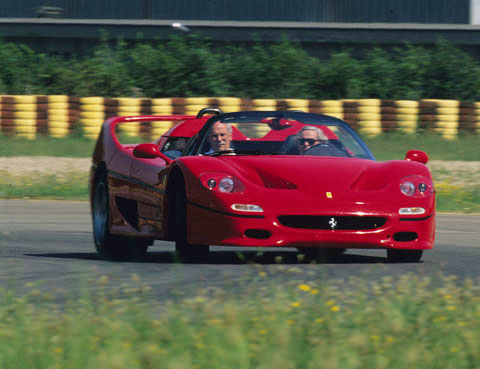
Riding with Paul Frere in Ferrari’s F50 at Pista di Fiorano. Notice the side load on the front tire and the lean in the body.
A CONTINUING EDUCATION
A lap of Pista di Fiorano, Ferrari’s on-site testing facility for all production and F1 cars, lived in my head. My first laps there were in a 328GTB. I returned to experience the first Testarossa and again for the 512TR. Then, on the fiftieth anniversary of the marque we were given the opportunity to try the F50.
It used the fundamentals of a 1990 Ferrari Tipo 036/037 F1 car that used a 3,500 cc 65-degree V-12 to produced 685 bhp at 13,000 rpm, but in the F50 the volume was increased to 4.7 liters and it was only asked to produced 513 hp at 8,500 revs. The sports car used a complete tub and body done in a complex blend of carbon fiber, Kevlar and Nomex. In my Automobile magazine story I described it as “…not a 333SP with upholstery. It is a road car created from a V-12 Formula 1 car of several generations back. It gives you the impression of driving a racing car on the street, but the hard metallic buzz that affects your focus in a racing car is reduced to a therapeutic hum here. The impression is intended, but this is a reasonably civilized sports car.”
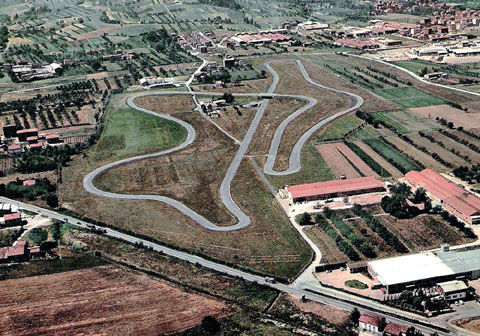
Pista di Fiorano shortly after construction. The complex in the center of the circuit includes Mr. Ferrari’s farm house, the data collection facility and shop. Just this side of the bridge is the pit entry and garage.
I described my growing confidence as I made my way through five laps of the circuit. “The understeer becomes a bother and I lift to get the front to bite. Dario Benuzzi, Ferrari’s famous test driver, uses full power here and balances the car with the tail detached. I don’t. Then later I do, too.”
My drive story sounded very experimental. It was my first drive with over 500 horsepower, but the car was created for an experienced amateur to drive to a track, play for the weekend and drive home with his ego inflated. It was friendly at the limit and was completely free of surprises. My first lap was a search and remember drive at about 7 tenths. My next lap was a bit faster and from that point I gave it all I had. I enjoyed learning what I had just experienced, but there was no danger of my ego being inflated.
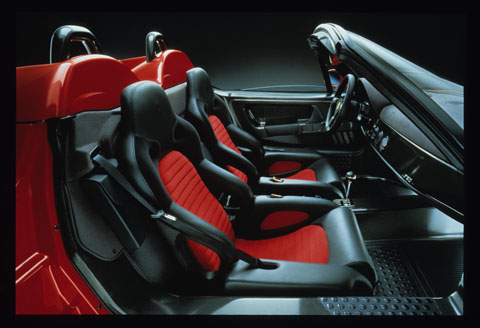
A memorable place for a car guy to spend a little time behind the wheel, but an even more memorable place to watch a master practice his craft.
Paul Frere was with us. He was a Belgian born journalist who had finished fourth in his home Grand Prix in an F1 car loaned by Ferrari. Nothing typical about that. He had also won the South African Grand Prix, the 24 Hours of Le Mans and the Spa 24 Hours. An accomplished journalist. I knew Paul because we both worked for Road & Track at one time, and Paul was in the office periodically. I approached him on the Fiorano pit apron as he was about to get into the F50 for his laps and asked if I could join him.
“Sure, Larry, hop in,” through a big smile.
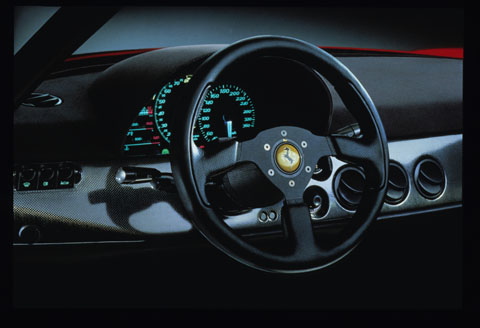
Seems simple enough.
Paul had driven Ferraris since they first appeared and won races in them. He had also driven on Pista di Fiorano since it was completed and knew it like his home track. As my seat belt clicked Paul was flat out in first, then second and approaching the first hairpin under full power. It begins with a shallow kink left then a very tight right hairpin, which Benuzzi does at full power, full lock and clouds of tire smoke. Paul simply rushed around it without drama and into the next left kink quickly back to full power, accelerating up to the broad right bend that would eventually circumvent a skid pad, but it wasn’t there yet. There is a second fast sweep left that brings you to a decreasing radius right onto a short straight. Paul didn’t lift, the car couldn’t get to a very high speed, but it went fast enough for a touch of left-foot brake as the direction changed. The straight is long enough to clear third gear and carries you up and over the bridge across the main straight and down into another decreasing radius, off-camber right. I was in awe. A long, left sweep done at redline in second and briefly in third puts you at the tightest hairpin left. The brakes are compressed to full on, but not violently and the car is never upset as it enters the hairpin. At his apex Paul was already flat and balancing the car through the fast right, changing to a fast left still accelerating and into fourth and still flat as we approached the unbanked 180 at the end of the circuit. Revs were still climbing. The 180 was approaching very quickly. I looked over at Paul to see if he is okay. He was 80 after all. He was absolutely calm and we were still accelerating as we arrived at the corner at some stupefying speed. He crushed the brake pedal as the steering wheel began to rotate gently. The front tires were so heavily loaded they gripped with no sign of understeer and he simply slid the rear around them until everything was lined up at the exit. Seamlessly the power found the rear wheels and we passed the pit entrance at well over 100 to begin our second lap. Five of those all matched — perfectly. Comfortably. Brilliantly. If we all go out and buy the latest, greatest supercars today and diligently practice until we are 80 without missing a day, we will never take that last corner that way or that fast. I was spellbound.
We lost Paul Frere a few months ago. He had always been a journalistic hero, but I had no idea who he really was until that ride. I may not know even now, but I do know a few things; he was brilliant, disciplined and very, very fast.
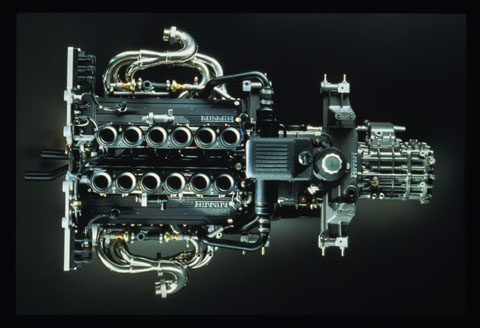
F50 Engine: 65° V-12 in nodular cast iron with Nikasil-coated liners
Volume, cc: 4,700 Bore/Stroke, cc: 85 / 69
Connecting rods: Ti6a14V titanium
Pistons: forged aluminum by Mahle
Compression: 11.3:1
Valve train: DOHC 60 valves (3 intake / 2 exhaust)
Fuel delivery: Bosch Motronic 2.7
Horsepower: 513 hp at 8,500 rpm
Torque: 347 lb-ft at 4,700 rpm
Weight, lb: 436.5
Gearbox: 6-speed and rev with ZV twin cone synchronizers
Ratios: 14/39, 19/38, 22/35, 25/33, 28/31, 31/38, Rev 17/22/43
Clutch: dry, twin plate
Oil temperature is controlled by an engine coolant radiator
inside the gear box to heat the fluid quickly and maintain its temperature.
Larry, you had me fooled here. At first, I thought this was just another “Look at me, I’m driving a Ferrari in Maranello!” story, and then, wham, the last paragraph, a beautifully written, powerful,and very moving tribute to Paul Frere. For those who want to know more about him, he wrote a book called “My Life Full of Cars,” published in 2000 by Haynes Publishing. It was originally written in installments for the Japanese magazine “Car Graphic.” While not an autobiography (there are no details of his private life), it is a chronicle of the entire automotive world from 1945 onwards, and I don’t think he missed too much. I got my copy at Retromobile a few years ago, and it is no doubt out of print, but you can likely find a copy on the Internet.
Thanks again Larry for what must be a unique story, and for the storytelling.
Brandy Elitch
Healdsburg, CA
Another wonderful story from Larry Crane. They just keep coming!
I first learned of Paul Frere when I bought his book “Sports Car and Competition Driving” in 1970. The book had been in print already 7 years by that time. And he continued to race like like a master until he was 80. Amazing.
Keep the stories coming Larry. I’m loving it!
Mary Ann Dickinson
Larry, as always a very interesting story. Very innovative blending Paul Frere’s tribute with his drive in an F50.
Thanks.
For those of you who may want to get a copy of “My Life Full of Cars” by Paul Frere, Amazon.com has it in hardcover for $26.37. It is in stock as I write this.
Bob Krueger
San Diego